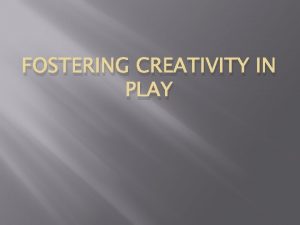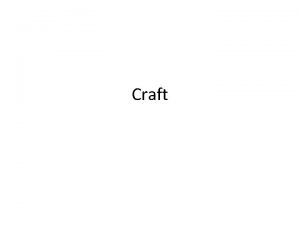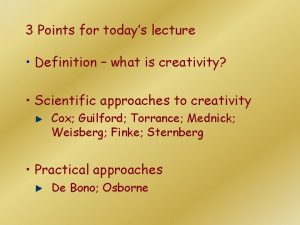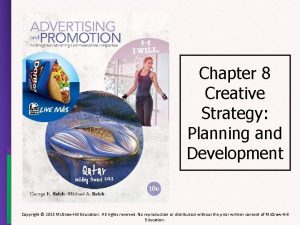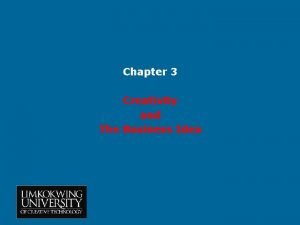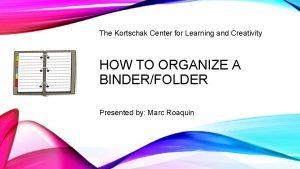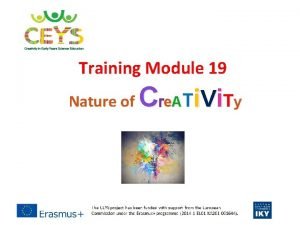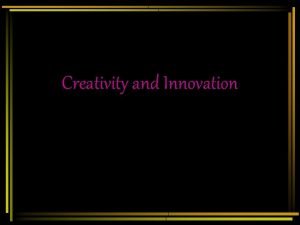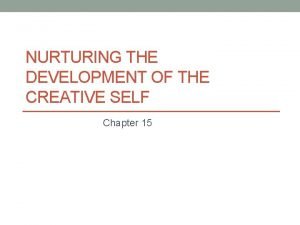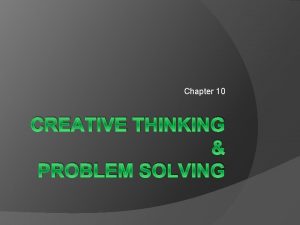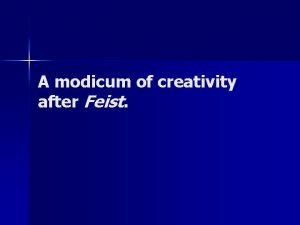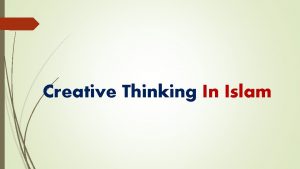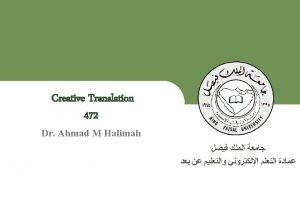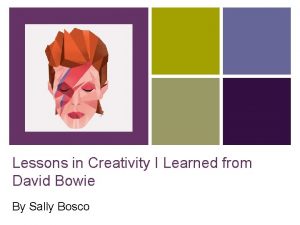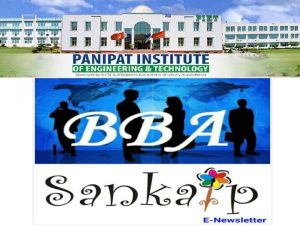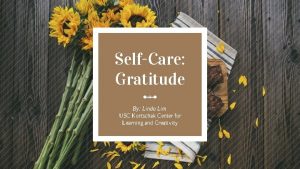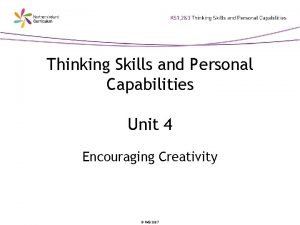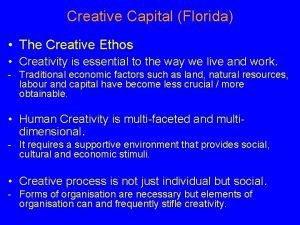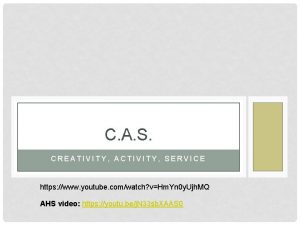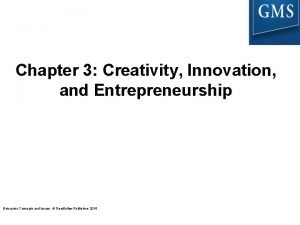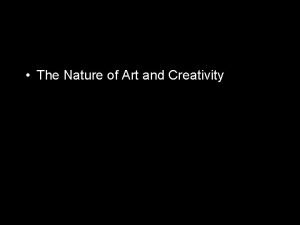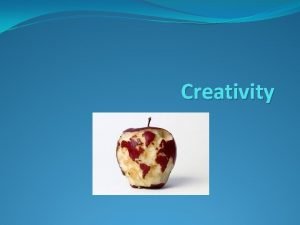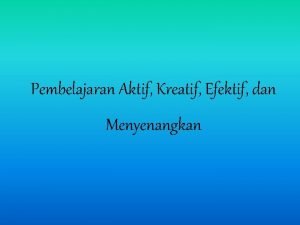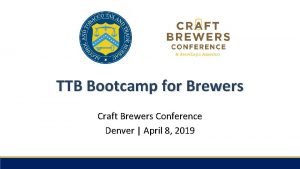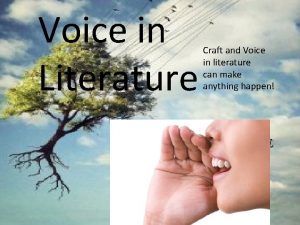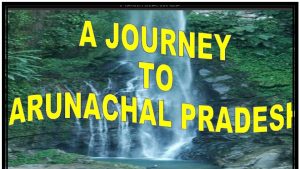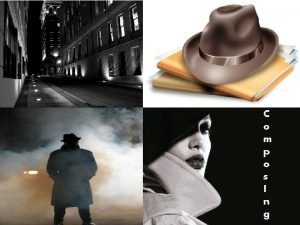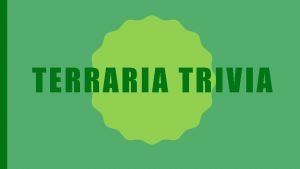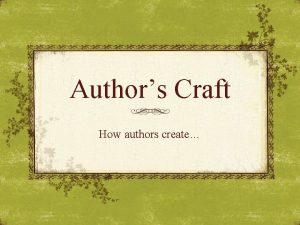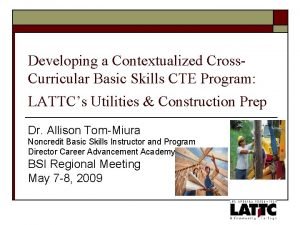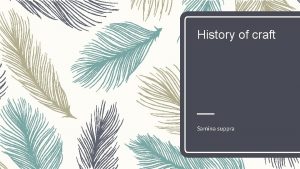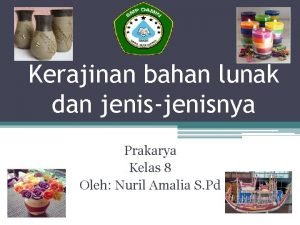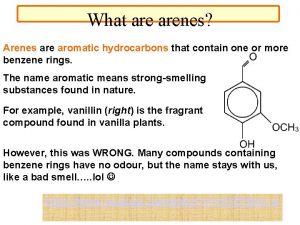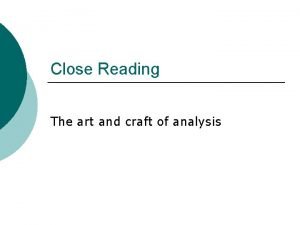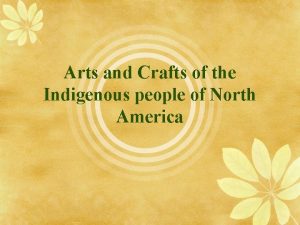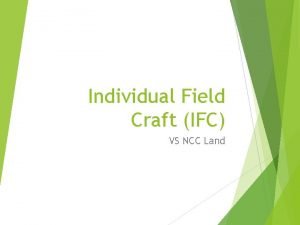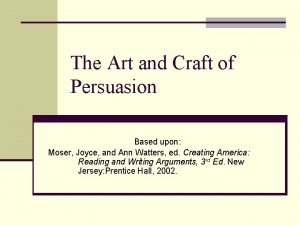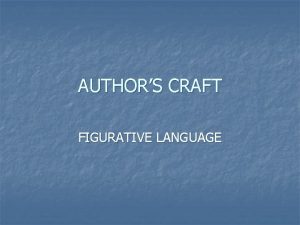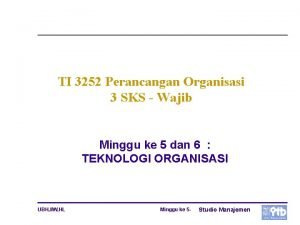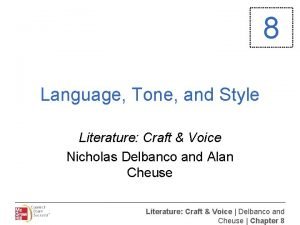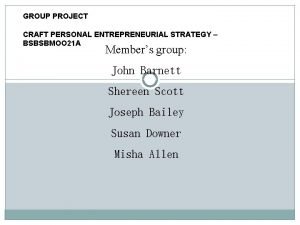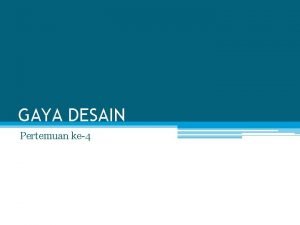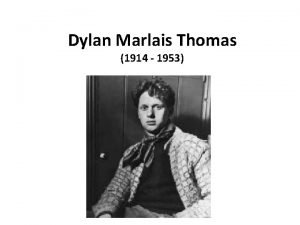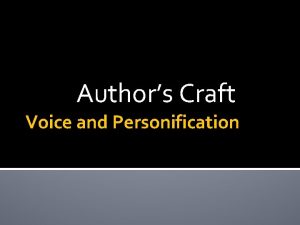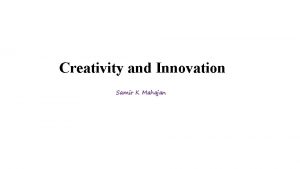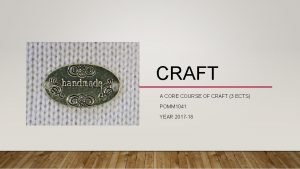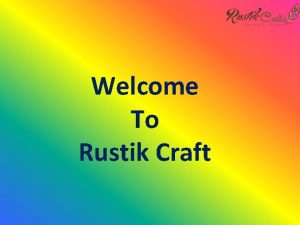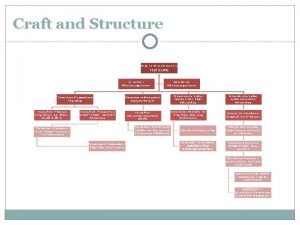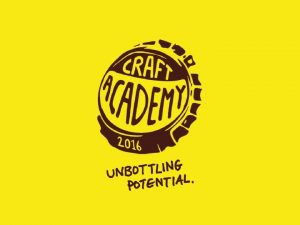Craft What is craft Expression of creativity through














































































































- Slides: 110

Craft

What is craft? • Expression of creativity through using hands (man made). • An activity involving skill in making things. • The word, after all, is the German Kraft, simply means power or ability.

• The traditional term craftsman and craftswoman are nowadays often replaced by artisan and rarely by craftsperson (craftspeople). • Craft is a form of transformation.

ART AND CRAFT • Most people do not see any difference between art and craft as they are both considered to be forms of creativity. • Art is a form of work that is the expression of emotions. Craft is a form of work, which results in a tangible output, for example, moulding and carving.

• Art is often described as unstructured and open ended. It has no limitations of expression, just like in painting. Craft on the other hand is structured, which means that it has a certain form that is visible. • Another thing that can be seen is that one can create duplicate craft forms, which is not possible with art.

Types of Craft The crafts in the Punjab are of two types: • 1. The crafts produced in the Rural Areas. • 2. The Royal crafts produced and flourished in Urban areas

Types of Rural Area Crafts • Cotton Textile • Basketry (bamboo, Reeds and Cane)

Cotton Textile • Textile designing is an art and it is as old as beginning of mankind. Nowadays, many different types of companies are involved in the production of textiles and clothing and some even have huge manufacturing plants in different countries.

• Since Pakistan is the 4 th largest cotton producer in the world. Due to constant availability of finest cotton supply, the textile industry is backbone of the Pakistan economy. • Khaddi, khaddar, khais and thread (dhaga) are the strength of the textile of Pakistan. • Approximately there are more than 1000 textile mills and exporters in Pakistan , located in major cities like Karachi , Faisalabad , Lahore , Gujranwala , Sialkot etc.

Categories of Textile • We can divide textile designers into following categories; Color Specialist, who predicts and forecast future color ranges. • • • Knitted fabric designer Woven fabric designer Carpet designer Print Designer Embroidery Designer Knitwear Designer Garment Designer Accessories Designer Stylist




Basketry • Cane Basket Work include stripped cane woven by skilled craftsmen to produce articles of utility such as baskets, hand bags, ladies bags, mats etc. in elegant designs decorated with floral patterns which make these articles popular due to their delicate craftsmanship. • In the northern areas and hill stations, the canes and the handicrafts made of cane are very famous among the tourists and holiday makers.

Basketry




Embroidery • Embroidery has been an old art/craft that has been around as long as people can remember. Over the years in Pakistan it's taken a beautiful turn, with various stitches being invented, and each as fabulous as the next one. • While a lot of the stitches are distinctive, and are named after the region they are mostly found in, such as a Sindhi Karhai, Kashmiri Karhai, there are even some that have even been named after the big politicians of Pakistan, such as a Benazir Stitch and a Nawaz Sharif stitch.

• Embroidery is one of the most required handicrafts of Pakistan the world over. Multan, Bahawalpur and surrounding areas are full of gifted men and women who produce one of the most adorable cross stitch. "Tilla" work, Pearl work and "Salma Sitary" work of NWFP are very famous throughout the country. Swat is wellknown due to thread embroidery, whereas, in D. G. Khan mirror work is done on clothes. Works of these types are called "Kadhai. " Chitrali "Patti, " that is woven on hand looms and Kadhai done on Chitrali Chugha is very famous.

Tilla, Salma & Sitara work


Chiatrali dress

• Similarly, sheesha or mirror work has also been used to decorate fabric. Sewing mirror into a design is hard enough, but when you combine elements of design and pattern into it, as well as bright, beautiful colors, it transforms the piece into an immediate piece of art. • These days, a lot of embroidery is done by machines. But the intricacy of handembroidery is still unbeaten.

Kashmiri stitch

Balochi Stitch



Embroidered cover from Hunza

Sindhi Stich



Sindhi Stitch




Desert Thar lady

Royal crafts produced and flourished in Urban areas • • Tiles Wood work Ivory Nakashi Silver and gold work Architectural craft Carpets

Multani Art: Blue Pottery and Tiles • The history of Multani arts and crafts also goes back to medieval period. • Kashi. Kari work, glazing and hand painting of ceramic products is an important art for which Multan is famous the would over. • The use of foliage branches and leaves of trees and superb richness of colours (mainly blue) in Kashi work is an evidence of Persian influence

• The highest quality Multani tiles have been used in shrines, mosques and other important buildings including house ever since. The shrines of Shah Yousaf Gardezi (1153), Shah Rukne Alam, Ali Akbar, mosque Nawaban, Shrines of Uchh Sharif in Cholistan and Talpur tombs in Sindh are classic examples of tile work.




Tomb of Shah Rukn-e-Alam

Uchh Sharif Shrines


Chiniot Wood Carving • Chiniot is famous world-wide for the quality and intricacy of its wood carving. • The carvers of Chiniot have achieved a level of craft and creativity and good that other artisans in Pakistan and around the world can only hope to attain. • A special kind of furniture and brightly colored lacquered woodcarving is made in chiniot. Tables, beds, swings and so on.





Hand painted camel skin





Camel skin painted lamps

Camel bone Products







Salt Sculptures of Khewaora & Khushab





Lacquer work





Mojari or Khussa • Mojari or Khussa is a style of South Asian handcrafted footwear produced in Punjab Pakistan and India. • Mojari are made by artisans mostly using vegetable-tanned leather. The uppers are made of one piece of leather or textile embroidered and embellished with brass nails, cowry shells, mirrors, bells and ceramic beads.

Khushas





Ivory




handicrafts

















Truck ART • With its all colorful floral patterns, depiction of human heroes with creative aspect ratios, calligraphy of poetic verses and driver’s words of wisdom, this form of art is truly a part of Pakistani transport tradition. • These truck bodies are perfectly painted by the street artists who can be found at Truck stands all across the country.

• Pakistani trucks are also used as means of displaying the owner or the Painter’s Poetic taste. It also serves as a calligraphic board as well as a notice board for public messages.

Truck art






 Creativity and play fostering creativity
Creativity and play fostering creativity Craft expression
Craft expression A quadratic expression is an expression of
A quadratic expression is an expression of Schermerhorn hunt & osborn 2003
Schermerhorn hunt & osborn 2003 Creativity and the business idea
Creativity and the business idea Geneplore model
Geneplore model Conclusion of creativity
Conclusion of creativity Planning creative strategy
Planning creative strategy Creativity innovation and invention
Creativity innovation and invention Robert sternberg five components of creativity
Robert sternberg five components of creativity Creativity business idea
Creativity business idea Usc kortschak center for learning and creativity
Usc kortschak center for learning and creativity Nature of creativity
Nature of creativity Conclusion of creativity
Conclusion of creativity Conclusion of creativity
Conclusion of creativity Creativity innovation and invention
Creativity innovation and invention Decision making and creativity organizational behavior
Decision making and creativity organizational behavior Lexical creativity
Lexical creativity Creativity support tools
Creativity support tools Chapter 4 creativity and the business idea
Chapter 4 creativity and the business idea What is creativity
What is creativity Anja sanskrit
Anja sanskrit Conclusion of creativity
Conclusion of creativity Forced combination technique definition
Forced combination technique definition Equivalence and equivalent effect
Equivalence and equivalent effect Torrance creativity test examples
Torrance creativity test examples Modicum of creativity
Modicum of creativity Barriers to creativity and innovation
Barriers to creativity and innovation Creativity in islam
Creativity in islam Components of creativity ppt
Components of creativity ppt What is creativity
What is creativity Ethics and creativity are ________.
Ethics and creativity are ________. Creativity and innovation
Creativity and innovation Awareness creativity and communication
Awareness creativity and communication Creativity of linguistic knowledge
Creativity of linguistic knowledge Berpikir kritis dalam keperawatan
Berpikir kritis dalam keperawatan Chapter 4 creativity and the business idea
Chapter 4 creativity and the business idea David bowie on creativity
David bowie on creativity Bisociative thinking
Bisociative thinking Problem solving and creativity
Problem solving and creativity Conclusion of creativity
Conclusion of creativity How pixar fosters collective creativity
How pixar fosters collective creativity Bill lucas creativity wheel
Bill lucas creativity wheel Usc kortschak center for learning and creativity
Usc kortschak center for learning and creativity Icedip model with example
Icedip model with example Creative ethos
Creative ethos Creativity in psychology
Creativity in psychology Communication creativity critical thinking collaboration
Communication creativity critical thinking collaboration Positive attitude for creativity
Positive attitude for creativity Creativity and personal mastery
Creativity and personal mastery Creativity creative acrostic poem
Creativity creative acrostic poem Thinking skills and creativity
Thinking skills and creativity Cas activity examples
Cas activity examples Creativity vs innovation examples
Creativity vs innovation examples Romare bearden rocket to the moon
Romare bearden rocket to the moon An introduction to critical thinking and creativity
An introduction to critical thinking and creativity Computational creativity market trends
Computational creativity market trends Steve jobs creativity is just connecting things
Steve jobs creativity is just connecting things Creativity capital
Creativity capital Rule governed creativity
Rule governed creativity Harvard business review creativity
Harvard business review creativity Tarnow fletcher furcation classification
Tarnow fletcher furcation classification Conversation of timber
Conversation of timber Who wrote night of the scorpion
Who wrote night of the scorpion Through one man
Through one man Craft brewers conference denver
Craft brewers conference denver Literature craft and voice
Literature craft and voice Thangka painting of arunachal pradesh
Thangka painting of arunachal pradesh Craft feedback
Craft feedback Karen yager craft of writing
Karen yager craft of writing How much hellstone ore for a bar
How much hellstone ore for a bar Craft acting school
Craft acting school What is authors craft
What is authors craft Electrical craft helper lattc
Electrical craft helper lattc Craft moves
Craft moves Craft meaning
Craft meaning Bahan lunak fiberglass memiliki struktur
Bahan lunak fiberglass memiliki struktur No2ch2ch2ch3
No2ch2ch2ch3 Peter heals the lame man craft
Peter heals the lame man craft Writer s craft
Writer s craft Craft distilling expo
Craft distilling expo Pola paper craft
Pola paper craft Presenter name
Presenter name Author's craft in the great gatsby
Author's craft in the great gatsby Craft facility layout
Craft facility layout Storage craft reseller
Storage craft reseller The santa ana winds joan didion annotation
The santa ana winds joan didion annotation Writers craft examples
Writers craft examples What is a craft
What is a craft Grasp acronym
Grasp acronym Judging distance in ncc
Judging distance in ncc The art and craft of persuasion
The art and craft of persuasion Robert david steele the new craft of intelligence
Robert david steele the new craft of intelligence Pos services for brewery
Pos services for brewery Black bat craft
Black bat craft The craft of scientific writing
The craft of scientific writing Rebecca craft
Rebecca craft Space craft escape
Space craft escape The craft of interviewing in realist evaluation
The craft of interviewing in realist evaluation Computerized layout planning
Computerized layout planning Rokodelstvo art & craft slovenija
Rokodelstvo art & craft slovenija Author's craft figurative language
Author's craft figurative language Contoh mediating technology
Contoh mediating technology Literature craft and voice
Literature craft and voice Words paint a thousand pictures
Words paint a thousand pictures Personal entrepreneurial strategy
Personal entrepreneurial strategy Brutal craft
Brutal craft Acts 4:32-37 craft
Acts 4:32-37 craft Gaya desain art and craft
Gaya desain art and craft Craft of scientific presentations
Craft of scientific presentations Dylan thomas in my craft
Dylan thomas in my craft
